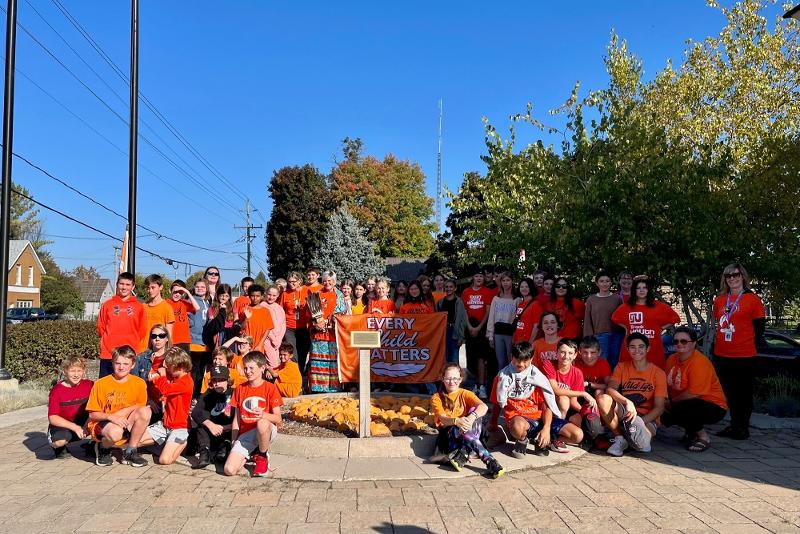The Township of Ramara and Brechin Public School recently joined forces to commemorate the National Day for Truth and Reconciliation. In a heartfelt event, art displays were unveiled that showcased the 46 articles of the United Nations Declaration on the Rights of Indigenous Peoples (UNDRIP). This article explores the significance of this initiative, highlights the importance of understanding Canada's history, and delves into the significance of protecting the rights of the First Nation, Inuit, and Métis peoples.
Art Displays Unveiled in Commemoration of National Day for Truth and Reconciliation
The significance of showcasing the 46 articles of the UN Declaration on the Rights of Indigenous Peoples
Art plays a powerful role in conveying stories, emotions, and messages. In commemoration of the National Day for Truth and Reconciliation, the Township of Ramara and Brechin Public School decided to utilize art as a means of remembrance and education. By unveiling art displays that showcase the 46 articles of the UN Declaration on the Rights of Indigenous Peoples (UNDRIP), they aimed to raise awareness and highlight the significance of Indigenous rights.
The art displays serve as a visual representation of the rights outlined in UNDRIP, allowing visitors to immerse themselves in the journey of reconciliation. Each artwork pays tribute to the principles enshrined in the declaration, fostering a deeper understanding and appreciation for Indigenous cultures, histories, and struggles.
Joined Efforts through Unity
The collaboration between the Township of Ramara and Brechin Public School
The unveiling of the art displays was a collective effort that brought together the Township of Ramara and Brechin Public School. By joining forces, they emphasized the importance of unity and inclusivity in the reconciliation process.
The Township of Ramara paved the way for this meaningful collaboration, providing a space within the Council Chambers to showcase the art displays and host the event. Brechin Public School, on the other hand, played a crucial role in creating the artwork itself, engaging students to learn about UNDRIP and express their understanding through artistic interpretation.
Amplifying Awareness and Understanding
Educational aspects of the art displays
Brechin Public School demonstrated their commitment to education by incorporating UNDRIP into their curriculum. Under the guidance of dedicated teachers and community members, students deeply immersed themselves in understanding the history, significance, and impact of Indigenous rights. This process not only equipped them with essential knowledge but also instilled in them a sense of empathy and respect for Indigenous cultures.
Colorful Interpretations:
The art displays feature a vibrant array of interpretations. Each artwork stands as its own testament, capturing attention with intricate details and heartfelt meaning. From paintings to sculptures, each piece carries a unique story.
An Authentic Learning Experience:
During the creation of the art displays, students embraced an authentic learning experience. They connected with Rosanne Irving, an Elder in the community, who generously shared her knowledge about the residential school system and the rights outlined in UNDRIP. This interaction allowed students to gain firsthand insights and deepen their understanding of these important topics.
Creating Dialogue:
The art displays aim to spark conversations and encourage dialogue about reconciliation, Indigenous rights, and Canada's history. Visitors to the Council Chambers can engage with the art, reflect on the powerful messages depicted, and share their perspectives.
Call to Action: Protecting Indigenous Rights
The role of the community and individuals in upholding Indigenous rights
The art displays not only commemorate the National Day for Truth and Reconciliation but also serve as a powerful call to action for individuals and the community at large. They remind us of our collective responsibility to protect and respect Indigenous rights in our daily lives.
By engaging with the art displays, viewers are encouraged to learn more about the rights of the First Nation, Inuit, and Métis peoples. This knowledge empowers individuals to challenge systemic barriers and contribute to establishing a more inclusive society that values and safeguards Indigenous rights.
Let the art displays serve as a catalyst for change, inspiring conversations, promoting empathy, and solidifying our commitment to truth, reconciliation, and the protection of Indigenous rights.
Conclusion
The unveiling of the art displays by the Township of Ramara and Brechin Public School represents a significant step in honoring Indigenous rights and promoting a deeper understanding of Canada's history. Through these artistic expressions, the community came together to commemorate the National Day for Truth and Reconciliation.
The art displays serve as a powerful reminder to protect Indigenous rights and work towards reconciliation. By engaging with the artwork and reflecting on its messages, we all have the opportunity to contribute to a more inclusive society.
Let us continue to foster dialogue, educate ourselves, and take action to support Indigenous communities and their rights. Together, we can work towards healing, understanding, and a better future for all.
FQA :
What is UNDRIP?
UNDRIP stands for the United Nations Declaration on the Rights of Indigenous Peoples. It consists of 46 articles that outline the specific rights and actions to be taken by governments to protect the rights of Indigenous peoples.
Why are art displays important in this context?
Art displays provide a visual representation of the principles outlined in UNDRIP, allowing for a deeper understanding and appreciation of Indigenous rights. They serve as a catalyst for conversations, reflection, and raising awareness about the significance of reconciliation and protecting Indigenous rights.
How can individuals contribute to protecting Indigenous rights?
Individuals can contribute to protecting Indigenous rights by educating themselves about Canada's history, engaging in dialogue about reconciliation, advocating for change, supporting Indigenous communities, and challenging systemic barriers. This can be done through continued learning, open-mindedness, and active participation in initiatives that promote inclusivity and respect.

